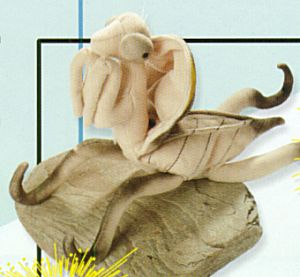|
|
The Amazing & Adaptable Walking Sticks
Stick Insect is the common name for the family of insects
scientifically named Phasmatodea. There are over
three thousand known types of stick insects in the world. And
probably many more that we haven't named yet. Stick insects
can be found all over the world, but most live in the
tropics.
All stick insects are vegetarians. They are shaped and
colored the way they are for camouflage. They look like the
twigs, bark and leaves of the trees they live on, or even
the lichen that grows on the trees. Some are so well hidden
that you won't notice them even if you look right at them!
They often even sway back and forth as they sit on a tree,
looking like a wind-blown twig or leaf, and some can even
change color to match the plant they are on. Stick insects
have claws and some have suckers on their feet, making them
able to walk up walls and even along branches upside down.
Stick Insects have some other very interesting survival
mechanisms, including the ability to grow back, over a few
molts, legs that have been lost to accident or predators.
They are, of course, normally green or brown to match the
vegetation, but a few are brightly colored and hide on and
in flowers, and some are striped. Some species have spines
and growths on their bodies that look like thorns or twig
stumps.
Many types of stick insects can also fake death, so that
predators that hunt live prey are not interested in eating
them. When threatened they simply drop to the ground and
play dead. Some also have spines on their legs and use them
for defense, and some give off a bad odor. One Australian
stick insect is not only spiny but curls up its abdomen to
try to look like a threatening scorpion.
The walking stick is able to grow to an astounding size in
just a few months. Adulthood is reached after five or six
months and adults live just a further six months or so.
Stick insects can vary in size from the tiny, half inch
(eleven and one half millimeters) long Timema cristinae of
North America to the gigantic thirteen inch (three hundred
twenty-eight millimeters) long Phobaeticus kirbyi from
Borneo. This Borneo giant spreads out over twenty-one inches
(fifty-five centimeters) with its legs outstretched, which
makes it one of the largest insects in the world.
Walking Stick insects drop their large (up to eight
millimeters) long eggs to the ground, where they lay until
they hatch, sometimes up to three years later. The eggs have
hard, hinged shells so the babies are well protected. Stick
insects have yet another amazing survival mechanism though;
they reproduce parthenogenically, meaning that an
unfertilized egg can still hatch. Some populations of stick
insects are made up of only females that are exact copies of
each other!
The best known stick insect is the Indian Stick Insect, also
known as the Laboratory Stick Insect because they are
commonly studied in the laboratory. They grow to around four
inches (10 centimeters) long. They are one of the stick
insects that reproduce parthenogenically. Males of this
species are unrecorded, although gynandromorphs (having both
male and female parts) are quite common.
More on Walking Sticks &
Insects
Magnificent Stuffed Praying Mantis & Insects

|